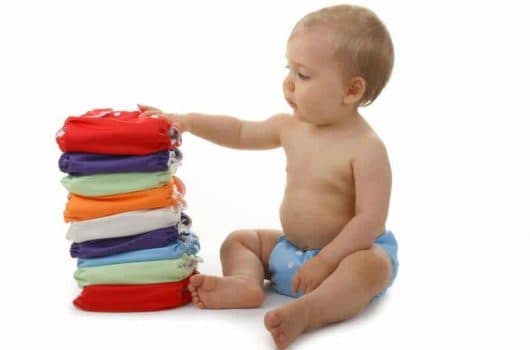There are only three certainties in life for a new mom: death, taxes, and diaper changes. As sure as the sun will rise in the east and set in the west, a proud new parent will have to change soiled diapers again and again—the average newborn requires ten diaper changes per day.
Thankfully, that figure becomes marginally more manageable as the infant matures. Nevertheless, mom is still looking at an eye-watering 2,500 diaper changes over the first two years until potty training can commence. And with the excessive expense and the mountain of landfill that disposable diapers entail, it’s little wonder many modern moms are switching back to the cloth diaper in droves. Today we’ll take you through everything you need to know about this eco-friendly, cost-effective option in our in-depth buyer’s guide.
- Features to Consider in Good Cloth Diapers
- Top 12 Best Cloth Diapers 2025
- 1. Best Cloth Diaper Overall: GroVia Hybrid Baby Cloth Diaper
- 2. Best Prefold Diapers: OsoCozy Prefolds
- 3. Best Pocket Diaper: Mama Koala One Size Baby
- 4. Best Premium Diaper: Charlie Banana Hybrid
- 5. Best All-In-One Diapers: Bambino Mio, Miosolo
- 6. The Best Cloth Diaper For Newborns: bumGenius All-in-One
- 7. Best Diaper Cover: Kanga Care Rumparooz Cloth Diaper Cover Snap
- 8. Best Budget Diapers: Gerber Birdseye Flatfold Cloth Diapers
- 9. Best Organic Diaper: Smart Bottoms Dream Diaper 2.0
- 10. Best Anti-leak Diaper: Kanga Care Rumparooz Pocket Diaper
- 11. Best Fitted Diaper: Osocozy Unbleached Fitted Diaper
- 12. Best for Potty Training: Babyfriend Washable Training Pants
- Cloth Diaper Buyer’s Guide
Features to Consider in Good Cloth Diapers
Before you rush out and pick up a big pack of cloth diapers to save money and the environment, it’s essential to work out which product is most suitable for you. The cloth diaper industry is perplexing for the rookie mom, with a baffling array of different makes and models to sort through. Here are the key things to consider when shopping for cloth diapers:
- Price: One of the biggest motivators for moms to splash out on cloth diapers is money. Although they cost more upfront, reusable cloth diapers work out several hundred dollars cheaper than their disposable cousins, even when you factor in the associated laundry costs.
- Type: Cloth diapers come in six different styles: flats/prefolds, fitted, pocket, contoured, all-in-ones, and hybrids. All our different, and each has unique advantages and disadvantages. To understand what they are and get an idea of which might be good for you, look at our Cloth Diaper Buyer’s Guide at the bottom of this article.
- Material: The inner layer of cloth diapers uses a wicking material like microfleece to keep your baby dry. When closer to potty training time, they often use a wetter-feeling fabric like cotton. On the outer layer, there’s one of three materials: wool, PUL (polyurethane laminate), and polyester fleece.
Top 12 Best Cloth Diapers 2025
1. Best Cloth Diaper Overall: GroVia Hybrid Baby Cloth Diaper
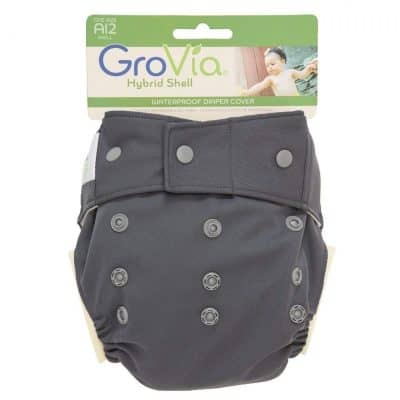
Editor’s Rating:
Diaper Type: Hybrid
Material: Polyester
Baby size: 8-30 pounds
Design:
Moms on the fence about going for cloth diapers will love the hybrid style, and GroVia makes the best of the bunch. Sold in 12 cute unique designs to suit boys and girls, this option boasts all the comfort, aesthetics, and eco-credentials of a cloth diaper will still retaining the convenience of a disposable. When the occasion calls—say you’re on a weekend away or visiting grandma for the day—you can use an eco-friendly disposable insert and just throw it in the trash. Under normal circumstances, however, you can put in the reusable inner lining to save both money and the environment.
Remember, you’ll only need a few of these outer shells as you don’t need to wash them after every use (unless they get wet). One of the best things about the GroVia Hybrid is how well the system snaps into place—fastening them is easy peasy and suits babies of (almost) all sizes.
Although they’re machine washable, you’ll have to dry them in the open air because the drier will see them shrink.
This product is an outer shell only, so you’ll need to purchase the inserts separately (GroVia sells soaker pads specially designed for these diapers). Absorbency depends on the type of soaker pad used, so grab a few heavy duties bamboo ones for night time.
Pros
- Affordable
- Several cute designs to choose from
- Convenient and flexible
- Doesn’t require much washing
Cons
- Shells must be hang-dried
- Prone to leaks overnight or at naptime
2. Best Prefold Diapers: OsoCozy Prefolds
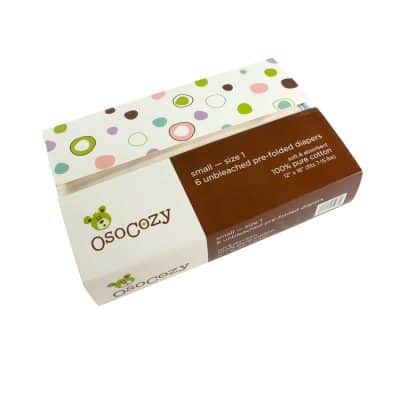
Editor’s Rating:
Diaper Type: Prefolds
Material: Indian cotton
Baby size:
- 6-15 pounds
- 15-30 pounds
Design:
These prefolds from Osocozy are top of the range for two reasons: absorbency and affordability.
To give you an idea of just how cost-effective prefolds can be, you’ll get a six-pack for a little over $10, making them among the most affordable diapers on the market. Of course, you’ll need to factor in the cost of your fasteners and waterproof covers as well, but that won’t break the bank. We recommend checking out this model from Kanga Care, which works wonderfully with Osocozy’s prefolds.
The Osocozy Prefolds also get top marks for the cushy material. Made from soft unbleached Indian cotton and featuring a lint-free thick gauze weave for extra durability, the middle panel contains eight levels of absorbency, which is far superior to other products at this price point and a godsend at minimizing leaks. The outer panels are thinner with four layers of absorbency, which affords easier folding and storage.
Washing these is easy: just toss them in the washer and either machine or line dry. Do note you’ll need to put these through 8 cycles before they’re fluffy enough to reach optimal absorbency.
And once your baby’s grown its diapers, you can repurpose these as burp rags to save even more.
Pros
- Super cheap
- Eight layers of absorbency in the middle
- Easy to fold and wash
Cons
- Must be washed multiple times before use
- Prefolds take time to get used to
3. Best Pocket Diaper: Mama Koala One Size Baby
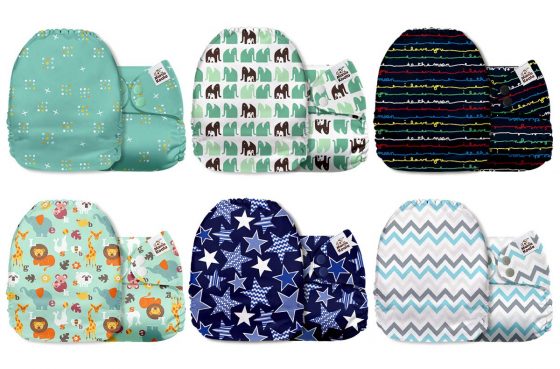
Editor’s Rating:
Diaper Type: Pocket
Material:
- Outer: 100% Water Resistant Polyester TPU
- Inner: 100% Polyester
- Insert: 80% Polyester and 20% Nylon
Baby size: 7 to 35 pounds
Design:
Mama Koala makes our favorite pocket diapers, and this user-friendly one-size model is the cream of the crop. Sold in a set of six for a very reasonable rate, the polyester diaper comes with a sturdy adjustable snap to fit babies of all sizes, which means you’ll only have to fork out for these once. The diaper is good for babies up to 35 pounds, by which time most are ready to move on to potty training.
One of the reasons we rate these above other pocket diapers is there isn’t any elastic on the back, which makes stuffing the inserts a breeze. You’ll get a six-pack of reusable microfiber inserts included in the deal, which are lightweight yet absorbent enough in most situations. Be aware, however, that the inserts inevitably start to stink, but it’s easy enough to buy separate charcoal bamboo liners, which smell fresh and offer better protection. Outside, the breathable TPU shell does an impressive job at containing leaks.
Pros
- One-size fits all
- Comes with microfiber liners included
- Suits a baby up to 35 pounds
- Possible to swap in custom inserts
Cons
- Included liners aren’t absorbent enough and may smell
- Not the most affordable option
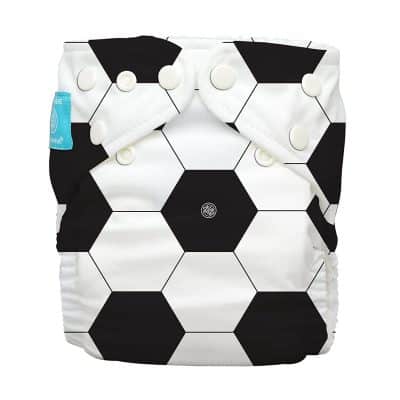
Editor’s Rating:
Diaper Type: Pocket
Material: Polyester
Design:
If you don’t mind splashing out on a diaper, these premium pockets from Charlie Banana are well worth your hard-earned money.
The first thing you’ll notice about these is cloth liners go into a pocket at the front of the diaper, which means less poopy mess when it’s time to change—and that’s a definite plus in our book. Disposables, on the other hand, come out through a flap on the end so you can swiftly toss them in the trash. Hemp inserts are available if you’re not fond of those that come included in the pack.
The two deluxe inserts that come included with the diaper are soft with a luxurious fleece top lining—your little one will love you for it (if only they could speak). Another great plus for Charlie Banana is their wide range of wonderful prints are fantastic to behold.
Stretchy elastic allows the diaper to grow with your baby; although we do feel adjustable straps work a bit better in that regard. Smaller babies, in particular, may struggle to find a snug fit.
Pros
- High-quality fabric feels heavenly on your baby’s bum
- Front-loading pocket makes removing the insert less messy
- Compatible with both disposable and reusable inserts
Cons
- Expensive
- Can be awkward for tiny babies
5. Best All-In-One Diapers: Bambino Mio, Miosolo
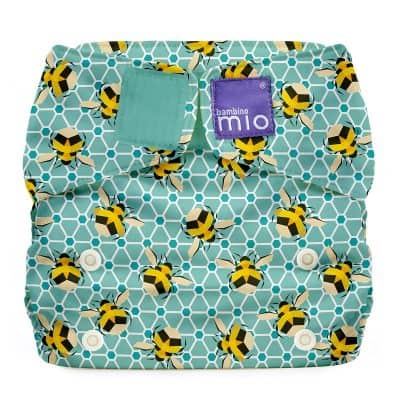
Diaper Type: All-in-one
Material:
- Outer: 100% polyester laminated to polyurethane
- Inner: 100% polyester
- Core: 85% polyester/15% nylon
Design:
Albeit expensive, all-in-one cloth diapers are fabulous because they’re so easy to use; you’d swear it was disposable. And Bambino Mio’s Miosolo is the best on the market for its super soft absorbent fabric and convenient one-size system.
As is the norm with all-in-ones, you won’t have to be worrying about separate inserts or outer shells, which makes these things a breeze to handle. The liner is tethered to the diaper, however, which you’ll need to pull out for washing, and putting it back inside is a bit of a chore. On the plus side, you can slip an extra booster pad into the pocket for more absorbency if need be.
Adjustable Velcro tab closures sit snuggly around the thighs for a comfortable fit, and these grow with your baby through the use of a resizing snap. This nifty feature lets you keep using the diaper until your tot hits around 35 pounds, which is just as well because the one-pack unit doesn’t come cheap.
And for the pint-sized fashionistas out there, there’s no denying these designs are incredibly cute.
Pros
- All-in-one style diaper is easy to use
- Adjustable straps grow with your baby
- Pull-out tethered insert for faster washing and drying
Cons
- Among the most expensive diapers on the market
- You have to stuff the inserts back in after each wash
6. The Best Cloth Diaper For Newborns: bumGenius All-in-One
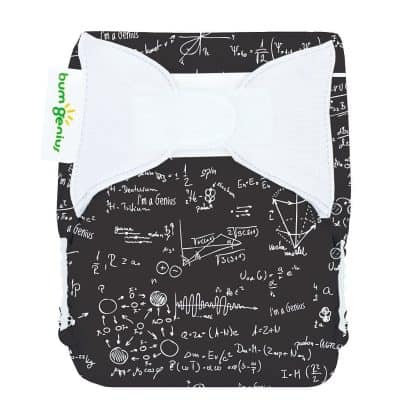
Editor’s Rating:
Diaper Type: All-in-one
Baby size: 6 to 12 pounds
Material:
- Inner and Outer: 100% Polyester
- Tabs: 95% Polyester, 5% Spandex
- Soaker: 80% Polyester, 20% Polyamid
Design:
Looking for a newborn diaper you can toss in the wash with minimal fuss? Then this all-in-one option from bumGenius is the perfect product for you. You won’t need to worry about buying or washing inner liners or outer shells separately because this diaper serves as a singular standalone unit—no stuffing or folding required.
Before you get too excited, though, note the bumGenius All-in-One is designed for itty bitty newborns only—specifically, babies between 6 and 12 pounds, so moms of larger tots are going to have to look elsewhere. And this short shelf-life adds considerably to the cost; you’ll have to buy a whole new diaper collection when your baby outgrows these.
This tiny toy’s diaper fits lower than most, just below the navel, which keeps the umbilical area clean. And it’s remarkably comfortable on a newborn’s delicate little frame, with loop closures and stretchy tabs ensuring a comfy fit. The included soaks are made from microfiber terry and do a wonderful job at keeping baby dry with help from the suede cloth lining. Leaks won’t be much of an issue either thanks to the elastic leggings that fit snuggly around your little one’s legs.
Pros
- Easy to change and wash
- No stuffing or folding required
- Perfect fit for newborns
- Comfortable and absorbent
- Anti-leakage elastic leggings
Cons
- For newborns only
- Will be expensive to buy new diapers when baby outgrows them
7. Best Diaper Cover: Kanga Care Rumparooz Cloth Diaper Cover Snap
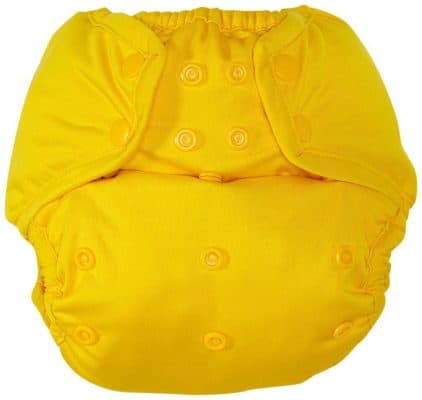
Editor’s Rating:
Diaper Type: Waterproof cover
Baby Size:
- Newborn: 4 to 15 pounds
- One-size: 6 to 35 pounds
Material: 100% polyester with TPU laminate
Design:
If you’ve opted for a prefold/fitted diaper underneath, then you’re going need a high-quality waterproof cover that wraps around the top. And the Rumparooz from Kanga Care is our top pick for two simple reasons: they grow with your baby and won’t leak.
The one-size model uses a snap hook and loop system to find a comfortable fit for baby’s between 6 and 35 pounds, so rest assured this one is good to go until it’s time to potty train. If you want the best possible fit for your newborn, you can get the smaller size (4 to 15 pounds) instead, which you’ll pay to replace when the baby gets bigger.
The waterproof polyester fabric comes with TPU laminate and stretchy elastic leggings to prevent leaks. Even though some wicking occurs through the label that’s sewn onto the TPU, the Kanga Care Rumparooz is still one of the best anti-leak covers out there. Incidentally, if you’d want a leak-proof pocket diaper, the same company makes a fantastic one of those, too.
It’s a baggy fit, as you’d expect for a cover, which allows it to work well with almost every prefold on the market (We recommend OsoCozy Prefolds. Pricewise, it’s midrange and offers excellent value for the quality of the merchandise. Remember: you’ll only need to grab 4 or 5 in total as you can wash them just once per day.
Pros
- Both newborn and one-size options
- Fits tots until potty training time
- Reasonably priced
- Good at preventing leaks
Cons
- It’s a cover so you’ll need to buy prefolds/fitted diapers
- Minor wicking can occur on the label
8. Best Budget Diapers: Gerber Birdseye Flatfold Cloth Diapers
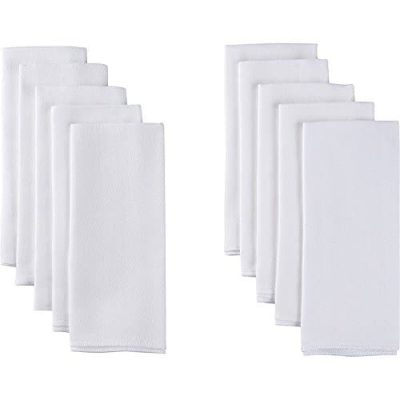
Diaper Type: Flats
Material: 100% Cotton
Design:
With all the other expenses that come with bringing a bundle of joy in this world, it’s understandable many parents might try to find ways to save on diapers. And this ten pack of no-frills flats from Gerber Birdseye is as cost-effective as a diaper can be. At less than $2 per diaper, which you’ll be able to reuse time and time again, you could spend as little as $50 on flats to last your tot right through until potty time.
Having said that, you will need to grab some fasteners and a few waterproof covers to go on top, so go out and get the hybrid diapers or outer shells of your choice (you’ll find plenty on our list).
And there’s one big fat caveat here: you get what you pay for.
Although the plain cotton material is quite comfortable, it’s a little too thin, which makes it less absorbent than other diapers on our list. These flats also tend to fray around the edges after multiple wash cycles, which makes them look a bit ragged and become harder to fold.
Nevertheless, if sticking to a tight budget is your biggest concern, then the Gerber Birdseye Flats are impossible to beat. The fact they work well as a burp rag long after your tot has become potty trained adds to the value-for-money factor.
Pros
- Super cheap
- Works well with most outer shells
- Easy to wash
Cons
- Too thin to be absorbent
- Prone to fraying and shrinking
9. Best Organic Diaper: Smart Bottoms Dream Diaper 2.0

Editor’s Rating:
Diaper Type: Pocket diaper
Baby Size: 10 to 35 pounds
Material:
- Inner: 55% hemp and 45% organic cotton
- Outer: water-resistant PUL
Design:
If your little one keeps breaking out in hives and you’re sure it’s not diaper rash, then there’s a good chance the baby could be allergic to polyester or other synthetics. In that case, it’s worth giving an organic material like hemp or cotton a try, and this diaper from Smart Bottoms is the best of the bunch. As a neat little bonus, these all-natural materials boast eco-friendly cred.
With a luxurious hemp and organic cotton blend inside, the diaper is extra soft and absorbent while remaining irritant-free (no harmful chemicals or solvents here). Outside, PUL fabric serves well as a waterproof shell and holds in leaks nicely. The sizable pocket has plenty of space for all sorts of inserts, affording greater flexibility in terms of choice. You’ll get one snap-in insert as part of the package, which is fairly absorbent, although you might want to get a thicker one for overnight sleeping.
The thing we love most about this organic diaper is just how easy it is to use, perfect for rookie parents who loathe the thought of doing a diaper change. The pockets snap in and out of place with ease, and the whole product can safely run through the drier and wash. Although it’s expensive, the Dream Diaper 2.0 will save you a heck of a lot of hassle. And the fact it’s made right here in America helps justify the expense.
Pros
- Organic cotton and hemp blend
- Eco-friendly materials
- Easy to change and wash
- Made in the USA
Cons
- Expensive
- Included inserts aren’t absorbent enough for some situations
10. Best Anti-leak Diaper: Kanga Care Rumparooz Pocket Diaper
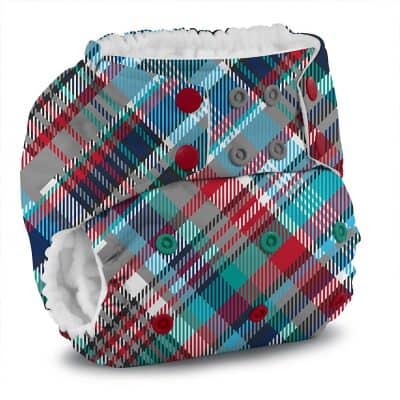
Editor’s Rating:
Diaper Type: Pocket diaper
Baby size: 6 to 35 pounds
Design:
One of the greatest struggles for any new mom is dealing with those ever-so-prevalent leaks. And the Rumparooz Pocket Diaper from Kanga Care provides the best possible solution to the dreaded blow out.
The brand’s impressive leak protection technology includes double inner gussets and soaker pads with six adjustable absorbency settings, which both work together in unison to contain any kind of mess. Tight-fitting elastic around the legs has both an inner and outer barrier to provide additional protection, and you can buy bigger bamboo or hemp 6-r inserts for an optimized anti-leak set-up. Rumparooz has put a patent on their anti-leak tech, which is a testament to how well the whole system works.
Like most premium pocket diapers, these things will set you back quite a bit as you’ll need 25 units or so. However, you do get adjustable snaps to fit babies up to 35 pounds, so at least you’ll be able to use them for life. They come in a wide range of cute prints, too, so you can be sure your tot will look adorable every day.
Like other pocket diapers, removing and restuffing the inserts for each wash is going to be a chore.
Pros
- Patented anti-leak system
- Fits babies up to 35 pounds
- Stacks of cute designs to choose from
Cons
- More expensive than other diaper systems
- Removing and re-stuffing the pockets for each wash is a chore
11. Best Fitted Diaper: Osocozy Unbleached Fitted Diaper
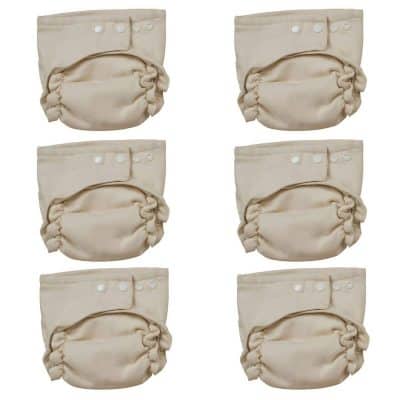
Editor’s Rating:
Diaper Type: Fitted diaper
Baby size: 7 to 18 pounds
Material: 100% Unbleached Birdseye Cotton
Design:
Osocozy makes our favorite prefolds, and they do a damn fine job on these fitted diapers as well—they’re considerably softer, more absorbent, and easier to use than their competitors.
The great advantage of the fitted diaper is, unlike prefolds, there’s no crafty origami-like folding process involved, which saves mom a lot of precious time. And considering they come in a six-pack for under 50 bucks, you’ll save heaps of money too when compared to pockets or all-in-ones.
The main reason we love Osocozy’s fitted diapers is their level of absorbency is second to none. The birdseye cotton material, which feels soft on the baby’s bum, comes in 12 separate layers for optimal absorbency, thus rendering leaks a thing of the past and offering a mess-free solution for sleep time. The natural material is super easy to launder, too: just toss it in the wash and tumble dry. Of course, you’ll need to purchase a bunch of waterproof covers. We recommend this diaper from Kanga Care
Be aware that these only fit babies up to 18 pounds, so you’ll need to find a new solution once your little one becomes…not so little.
Pros
- Affordable and convenient fitted diaper
- 12 layered birdseye cotton for optimal absorbency
- Works well for overnight sleeping
- Easy to launder
Cons
- Only fits babies up to 19 pounds
- More laborious than all-in-one or pocket diapers
12. Best for Potty Training: Babyfriend Washable Training Pants
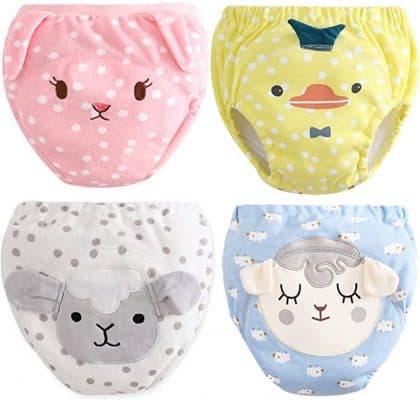
Editor’s Rating:
Diaper Type: Training diaper
Baby size: 18 months to three years
Material:
- Outer layer: 100% Cotton
- Inner later: waterproof cotton interlining
Design:
When your little one finally reaches the potty training stage (hallelujah!), you’ll need a set of diapers that are comfortable and capable of containing minor leaks—somewhere between baby diapers and big kid underwear. Enter the training pants, a halfway solution for little kids learning to potty.
We love these pants from Babyfriend because they’ve got a soft and waterproof cotton interior that’s both comfortable and absorbent; it’s no big deal when your tot has a little accident. A stretchy elastic waistband makes them easy to whip on and off, encouraging your child to learn how to potty the grown-up way. Washing is easy enough as well, just throw them in the drier, and you’re good to go. Five training pants come included at the low-price point, and you get to choose from five fun and unique designs.
Pros
- Effective potty training solution
- Five pack is cheap
- Easy to wash and dry
- Stretchable elastic makes it easy to take on/off
Cons
- Only suitable for potty training kids (18 months to three years)
- Won’t absorb big messy leaks
Cloth Diaper Buyer’s Guide
Cloth diapers come in a bewildering array of materials and types, creating a source of confusion for the first time mom. But with a little patience and some systematic research, it won’t take too long to work out what you want. And we’ve made the process a whole lot easier by compiling this comprehensive cloth diaper buyer’s guide.
The Advantages of Using Cloth Diapers
The average baby requires 2,500 diaper changes until their old enough for potty training, and that would cost you an eye-watering $2,000 if you went for a premium disposable brand. Getting enough cloth diapers to see you through the first two years, however, will only set you back $300 to $700, including laundry costs.
Furthermore, if you’re thinking of bringing a second bundle of joy into the world at a later date, then you could hand-me-down your reusable diapers for even greater savings.
It’s also worth considering the environmental implications of the disposable diaper. Those 2,500 used diapers will create a miniature mountain of landfill, not to mention all the additional plastic bags required to contain the hazardous waste.
And finally, cloth diapers are free from dyes, gels, and other chemicals found within disposable diapers that can irritate an infant’s delicate skin.
The Disadvantages of Using Cloth Diapers
Of course, cloth diapers aren’t the perfect solution—there are several reasons why some parents prefer to go with disposables instead.
Cloth diapers are notably less absorbent than disposables, so you’ll have to do the dreaded diaper change much more often as there’ll be a higher likelihood of leaks. Failing to provide a prompt change will result in diaper rash, which is extremely uncomfortable for your little one.
The other major con is that cloth diapers require a massive amount of extra laundry, usually around two or three additional loads per week. All that extra washing is going to take a vast amount of time and add substantial sums to your quarterly utility bill. If you don’t have a washer and drier at home, then you’ll spend even more time and money hanging around the local Laundromat.
And because you wash your diapers rather than throw them away, you’ll have to put up with being uncomfortably close to poop every day.
The Different Types of Cloth Diapers
A major cause of confusion for first-time moms is all the different types of cloth diapers out there. We’ll cover the top six cloth diaper types, including their key considerations.
Flats and Prefolds
Flats and prefolds are one of the most popular budget-friendly cloth diaper types out there. These no-frills options are pretty much just a plain piece of rectangular cloth, so you’ll need to learn origami-style folding skills to wrap them around your baby’s bum. Once you’ve mastered the art, you fasten them together with a safety pin or a snap and then put a separate waterproof diaper cover on top to keep your baby’s clothes dry. Sound a little outdated? In many ways, it kind of is, but grandma’s old-fashioned way of doing things still works a treat today.
Prefolds are almost identical to flats—the key difference here is the pre-sewn piece of cloth has already been divided into three sections, with the middle area being extra absorbent.
Although flats and prefolds are temptingly cheap, you’ll need to factor in all the necessary accessories when making a cost comparison. The separate diaper covers, as well as the snaps and pins, add up over time.
Who they’re best for: Given their low price point, flats and prefolds are perfect for budget-orientated moms who want to spend as little money as possible. The time investment, however, is significant, so these are more suitable for the stay at home mom than the busy executive mom.
See our favorite prefold diaper here.
Fitted Diapers
As the name implies, these ready-to-wear diapers come ready to fit your baby’s bum, which makes them a whole lot easier to prepare than flats. Stretchy elastic openings hug your tot’s legs to minimize leaks, and the entire fabric is extra absorbent to soak up spills. Built-in snaps or Velcro fasteners mean it’s easy to find the perfect fit, although you will still have to add a waterproof shell on top.
The downside is fitted diapers are pricier than flats and require more work in the laundry room as there are more layers to contend with.
Who they’re good for: Fitted diapers are great for parents who feel daunted at the prospect of folding up flats but don’t want to splash out on expensive all-in-ones/pockets.
See our favorite fitted diaper here
Contoured Cloth Diapers
Contoured cloth diapers are kind of like the halfway point between fitted and flats. These midrange models feature an hourglass shape to fit snugly around baby’s thighs and a tab that fastens the whole thing in place above the belly. As a result, getting these on is far less complicated than flats, yet their relatively simplistic design makes them cheaper than fitted cloth diapers.
Another great thing about contoured diapers is they use minimal material, making them easier to wash and dry en masse. Given these are exceptionally comfortable, some moms prefer to use a contoured cloth diaper at night and a different model during the day. You’ll still need a waterproof cover over the outside.
Who they’re good for: Contoured diapers are an affordable option for moms who don’t want to fork out for fitted diapers nor fold-up flats for everyday use.
All-In-One Cloth Diapers
No outer layer to slip on or origami-style folding required here, the all-in-one lives up to its namesake by providing everything at once. Just like a disposable diaper, the outer liner, inner liner, and wicking layer come already sewn together to create a complete package, and you’ve got elastic leg openings you can easily slide on and off. And once you’ve changed them out, you can just throw the whole thing into the laundry at once.
These premium diapers are much easier to use than all other types but require a bigger financial outlay.
Who they’re good for: All-in-ones are the cream de la cream of the diaper world, perfect for well-heeled parents happy to spend extra to save on cleaning time. These also make superb supplementary diapers to lighten the burden when leaving the baby at grandma’s house.
See our favorite all-in-one diaper here
Hybrids:
Hybrids are like a cross between fitted diapers and all-in-ones and all feature an outer waterproof shell. The name hybrid stems from the fact that the inner layer can be either an absorbent reusable cloth or a disposable insert.
When it’s changing time, you just pull the inner layer out and replace it with a fresh one, leaving the outer shell as is (assuming it’s dry). This way, you can have fewer outer shells, which are more expensive, and buy lots of cheaper inner liners instead. The option to use disposable liners comes in handy when traveling, as you don’t need to worry about washing.
Hybrids are either a set size (you replace them when your baby grows) or one-size (grows with your little one). Although they may seem complicated at first and are somewhat prone to leaks, hybrids are more flexible than other options.
Who they’re good for: Hybrids are great for moms who move their babies around a lot and would like to alternate between disposable and reusable inserts.
See our favorite hybrid diaper here
Pocket Diapers:
Pocket diapers are a waterproof outer shell that contains a “stay-dry” polyester lining called a pocket, in which you can place an absorbent pad or prefold.
The primary advantage here is you can use different inserts for different situations, altering the level of absorbency and the position as required. On the downside, they’re a bulky fit, and the process of unstuffing the pad or prefold can be a little icky.
Who they’re good for: Pocket diapers are perfect for moms who want to be able to adjust the level of absorbency.
See our favorite pocket diaper here
What Diaper Material Should I Go For?
After the type of diaper, the second key consideration is material; you’ll need to wash your diapers often, and they’ll rub directly onto your baby’s skin. Here’s a rundown of the top diaper materials:
The Inner Layer:
Most diapers contain an absorbent inner layer that keeps your little one feeling comfortable and dry all day long. Micro fleece is one of the most popular materials for its soft texture and super wicking ability. If your baby is ready for potty training, it’s best to use a material that allows them to feel wetness like cotton or bamboo.
In either case, avoid using synthetic materials if your baby has allergies and go for something natural like hemp or organic cotton instead.
The Outer Layer:
Cloth diaper outer layers come in one of three different materials:
- PUL (polyurethane laminate): Cotton material with a thin film of plastic melted onto the fabric. It’s breathable and lightweight, which is excellent for hot climates, and comes in a wide range of colors and prints. Works well underneath clothes.
- Polyester fleece: Affordable fabric that’s even more breathable than PUL, so it’s good at avoiding rashes and other irritations.
- Wool: A naturally absorbent material that’s waterproof when treated with lanolin. Odor-resistant and antibacterial properties allow it to be reused more often. All-natural fibers are eco-friendly, and its breathability makes it comfortable for overnight wear. Expensive and difficult to care for (hand wash, natural dry, and regularly re-apply lanolin).
How Many Cloth Diapers Do You Need?
Although cloth diapers are considerably more cost-effective than their disposable counterparts, they’re still going to set you back a sizable sum, so it pays to buy no more than you need.
So what’s the magic number? How many cloth diapers should a new mom buy?
There’s no real answer because it all depends on how often you plan to do laundry. Most moms decide to use disposable diapers during the first few months of a newborn’s life as your baby will soil itself often and outgrow the diapers quickly.
After three months or so, your baby will require a diaper change eight times per day on average. So if you’re a stay-at-home-mom and have plenty of time on your hands, you can potentially get away with stocking 16 if you’re willing to wash them every other day.
But no-one wants to live life in the laundry room, so if you can afford it, you’re better off opting for 24 or 36. Grab at least six waterproof covers as well—unless you go for all-in-ones/pockets/hybrids, which don’t need them.
How Often Should You Wash Cloth Diapers?
The more diapers you’ve got, the less you’ll need to wash them. However, there’s no point stockpiling a mountain of diapers because you’ll still need to wash them every few days or so. If left to fester any longer than that, you’ll stink out the house, and they’ll suffer unsightly stains.
Plan on washing a load of diapers every two to three days regardless of how many you intend to buy.
How Do You Wash Cloth Diapers?
Doing laundry is the main thing that turns parents off going down the cloth diaper path—but it’s not nearly as icky or tiresome as you may think. Although laundering dirty diapers is a something of a chore, the simple three-step task is well worth the monetary and environmental savings involved.
1—Remove the Diaper
Take off your baby’s dirty diaper the moment you realize it’s been soiled and immediately flush any feces down the toilet. Store the diaper in a hamper (some parents prefer to use a special diaper pail) until you’ve got enough to wash a full load.
2—Wash the Diaper
Put a big load of diapers on together to save time and money; anything more than eight diapers will suffice. Run a cold cycle first to loosen up the gunk, then add detergent and run a second warm or hot cycle to do a deep clean. If your washer has the option, it doesn’t hurt to do an extra rinse at the end.
We recommend you use baby-friendly detergent, which is free from softeners, brighteners, dyes, perfumes, and allergens. These additives can clog up inside a cloth diaper to ruin its moisture-wicking ability and potentially irritate a baby’s sensitive skin.
3—Dry the Diaper
The best way to dry your diapers is outside under the sun because doing it au natural is eco-friendly and will reduce your utility bill. If the weather’s not behaving or you just don’t have the time, most diapers can be machine dried on a medium or low setting. Always double-check the manufacturer’s instructions first to avoid ruining a brand new diaper (yes, we’ve been there).
If that all sounds like too much, there is one other, albeit quite expensive, option: the professional diaper cleaning service. These companies collect your dirty diapers from your door, wash and dry them, then drop them off again in a day or two. Although this comprehensive service comes at a hefty cost, it’s becoming increasingly popular among high-income earners who don’t like the environmental impact of disposables.
From dirt cheap prefolds to top of the range all-in-ones, the cloth diaper comes in many different shapes and sizes to suit all sorts of families. But they all have one thing in common: you’ll save vast sums of money and reduce the build-up of landfill when compared to using disposable diapers.
Take a look through our Cloth Diapers Buyer’s Guide to wrap your head around the finer details of the product and work out which option is the best fit for you. Once you’ve found the diapers that’ll suit your baby best, if you’re looking for somewhere to store your diaper-change essentials, these bags will help you keep your cloth diaper and inserts in one place. Happy nappy changing, people!
